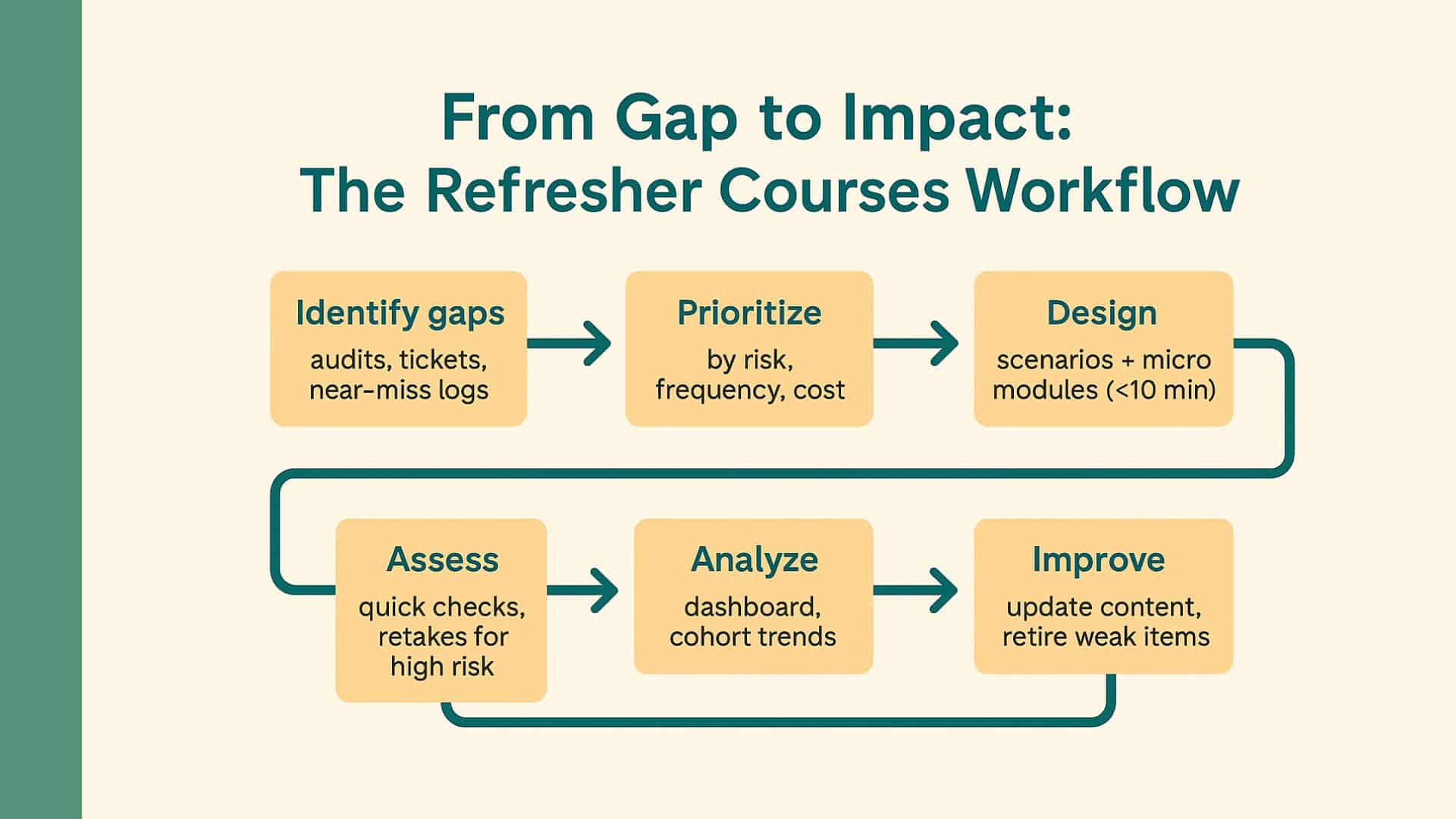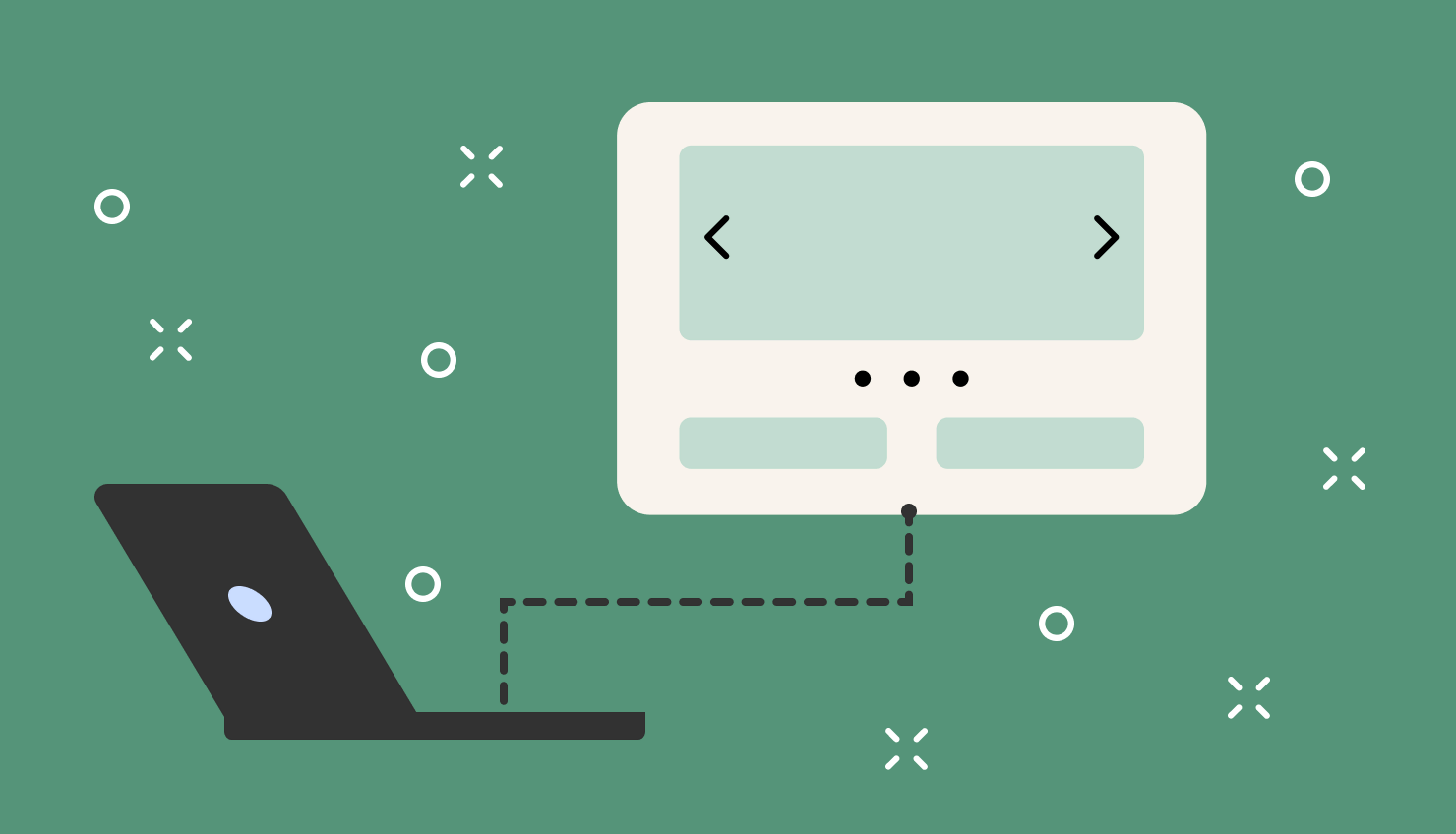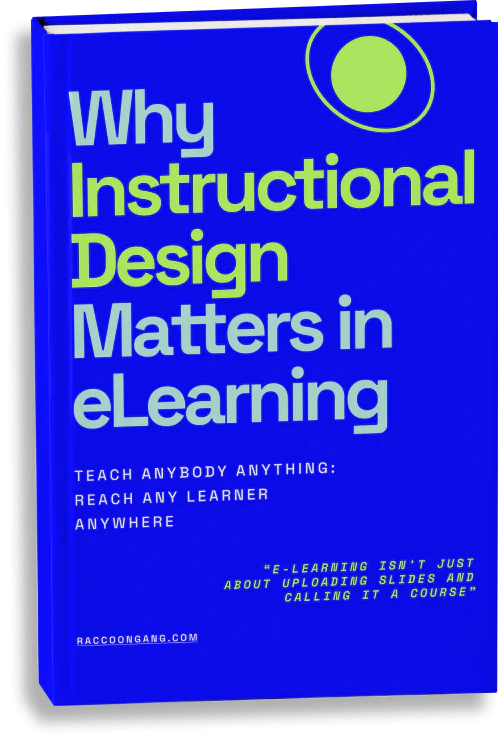In this article, we will review the core goals and benefits of refresher training and provide examples and practical tips based on our extensive experience in the field.
Keep in mind that you are getting refreshment training, meaning you don’t start from zero. You reinforce what the workforce already knows. You close gaps that appear with time, turnover, or change. How do you do that? With a well-thought-out and custom-designed refresh course — a short course that updates existing knowledge and practice for compliance or safety, similar in spirit to targeted continuing education courses.

The “Refresher Courses Impact Points” chart highlights how refresher training improves compliance, safety, and performance by reducing incidents and enhancing operational accuracy.
What is Refresher Training?
Refresher training is a focused update on already learned skills and rules. Its purpose is to prevent skill fade, align behavior with current standards, and reduce risk. It turns policy into daily habits. It also proves compliance with clear records and assessments.
In 2025, over 83% of businesses use an LMS for employee refresher training. It helps deliver short, focused updates that reinforce what people already know and should still be doing on the job. The aim of a refresher is simple: stop skills from fading, align daily behavior with current rules, and cut avoidable risk. When this periodic staff training runs on a clear schedule and ties to real tasks, policy turns into routine practice, and you also get the records, scores, and sign-offs that satisfy audits.
Core goals of refreshers:
- Prevent skill fade and errors
- Align behavior with current laws and standards
- Reinforce safety-critical procedures through timely safety training renewal
- Close gaps found in audits or incidents
- Provide evidence of compliance with records and checks
- Reduce risk to people, assets, and brand
- Improve consistency across sites and teams
- Boost performance with targeted practice
Initial Training VS Periodic Refreshers
Think of initial training as a foundation that you can further build on. It is broader and longer, and it usually happens during onboarding or certification, covering concepts, procedures, and tools from the start, so employees can perform their given role.
Periodic refreshers maintain that foundation. They are shorter and more selective, and you schedule them based on risk, regulatory dates, or signs of skill decay. They respond to real change — new rules, audit findings, incidents, or equipment updates — by focusing on the small set of tasks that cause most errors. Quick checks confirm retention, ensure records stay current, and show leaders that training is not a one-time event but an ongoing process.
Benefits of Refresher Training
Surveys show that it is highly unlikely to get a perfect 100% completion rate for your training, and it’s better to aim for about 95%. But even then, refresher training pays off significantly across the business. It protects people, revenue, and reputation. Let’s take a closer look at the benefits of refresher training, and you can see for yourself what you will gain if or when you decide to add several refreshers to your workflow.
Maintains Compliance with Laws/Regulations
Rules shift, interpretations evolve, and new guidance arrives with little warning, so your people need timely updates they can complete quickly, along with records that prove it happened. Conducting a regular refresher means closing that loop by turning changes into short tasks with clear sign-offs, quiz scores, and attestations you can surface during an audit. When inspectors arrive, you show control because policy and practice match on the floor; citation numbers drop, rework shrinks, and you avoid the ripple costs that follow a finding — this is the essence of ongoing compliance training updates.
Reinforces Critical Knowledge
Even experienced teams forget rarely used steps, especially under time pressure, which is why brief modules and job aids tied to real workflows bring the right action back to the top of mind. You can target weak spots by role and site, use quiz data to refine the plan, and focus repetition on the few errors that drive most defects. Over time, quality stabilizes across shifts because people see the same cues and follow the same playbook.
Improves Employee Confidence and Performance
Confidence rises when employees know exactly what “good” looks like today, not last year, and refreshers deliver that clarity without pulling them off the job for hours. With less guesswork and hesitation, output becomes steadier, error rates fall, and managers get clearer signals about where to coach next. Teams handle exceptions faster because they’ve practiced their decision points, leading to fewer escalations and a smoother customer experience.
Prevents Skill Decay in Safety-Sensitive Roles
High-stakes tasks decay without practice, so short, scheduled drills and safe simulations keep response skills ready for the moment they matter. Checklists and brief scenarios rebuild muscle memory, making the right move feel automatic even when stress is high. By catching small slips early and correcting them in context, you reduce near-misses first and then see incident rates trend down over time.

The “Training Cost Case” slide presents key statistics showing the financial benefits of investing in effective employee training and microlearning.
Refresher Training Examples
Every great executive and leader will usually wonder at this point — well, what this work looks like when it hits the floor and has to earn its keep. Over the years of working in e-Learning and creating customized LMS for businesses, we gathered extensive insights into what refresher training courses look like and what they entail.
Health and Safety Refreshers
Short modules that keep on-site and studio staff safe during production and support work.
- An online proctoring team ran quarterly ergonomics refreshers. Support reps adjusted setups and reduced strain reports.
- A university’s media lab posted short lab safety refreshers in the LMS. Students passed a checklist before booking equipment.
- An edtech studio required fire drill refreshers for on-site staff. Floor wardens practiced routes using a micro-module.
Cybersecurity Awareness
Brief updates that reduce breaches across platforms handling student and staff data.
- A MOOC platform ran phishing simulations for course authors. Click rates fell after two quarterly refreshers.
- A K-12 LMS issued a 15-minute data privacy refresher. Teachers reviewed FERPA basics before the term started.
- A tutoring marketplace pushed MFA and password refreshers. Creators enabled MFA and cut account recovery tickets.
Customer Service Updates
Targeted refreshers that sharpen tone, triage, and product knowledge in support teams.
- An LMS vendor released a “tone and triage” refresher. Agents practiced chat replies with real tickets.
- A digital academy shared refund policy updates via micro-courses. Support handled edge cases with fewer escalations.
- A bootcamp ran quarterly empathy refreshers using call clips. Advisors applied de-escalation phrases during peak periods.
Equipment Operation Training
Quick drills that keep media and lab equipment used correctly and safely.
- A recording team used quick gear refreshers for studio bookings. Staff passed pre-use checks on mixers and mics.
- A campus eLearning center posted VR headset care refreshers. Student workers cleaned lenses and logged issues.
- A video team ran gimbal setup refreshers before events. Fewer retakes and smoother footage followed.
Policy/Procedure Changes
Fast updates that turn new rules into daily actions with proof of completion.
- A university updated its academic integrity rules. Students completed a plagiarism refresher before submitting work.
- An edtech company revised content QA steps. The authors passed a short SOP refresher before release.
- A language app changed its data retention policy. Staff took a five-minute refresher and signed attestations.
These examples follow a simple pattern with a clear trigger, a tight format, and a measurable result, giving you updates that fit the workday instead of fighting it. Records show who completed what and when, metrics reveal the lift that followed, from fewer errors to faster handling time. Use the patterns to brief managers, set a sane cadence, and fund the pieces that deliver results.
How to Create an Effective Refresher Course
Before we design content, we design outcomes. Executives want fewer incidents, faster resolution, and clean audits without pulling people off the floor for hours. A practical refresher course does exactly that. It targets the few moments that drive most risk and cost, fits inside the workday, and proves impact with hard numbers. The steps below show how to build that system with data, realistic scenarios, and tight feedback loops—so you improve performance while keeping operations moving.

The “From Gap to Impact” workflow illustrates the continuous improvement process for refresher courses — from identifying knowledge gaps to assessing, analyzing, and improving training effectiveness.
Identify Knowledge Gaps
Start where risk and cost show up: audits, QA escapes, tickets, near-miss logs, and customer complaints. Look for patterns by role, site, vendor, and shift to see where performance slips when pressure rises. Then speak with supervisors, SMEs, and a few frontline staff to confirm the root causes behind those numbers. Define success as fewer incidents, faster handling time, higher first-time accuracy, or cleaner audit findings, and set a baseline you can measure against later.
Use Scenario-Based Learning and Microlearning
People remember decisions they had to make, not slides they had to read. Build short scenarios that mirror the stressful moments that cause most errors, and let learners choose actions with immediate consequences.
Use microlearning principles to boost concentration and completion rates. Keep each module under ten minutes so managers can fit it between tasks without hurting service levels. Space releases are scheduled over weeks to combat forgetting, and job aids are attached inside the LMS so the proper checklist appears at the exact step of work.
Include Assessments and Feedback Loops
Treat every refresher as a small experiment with clear pass marks and retakes for high-risk tasks. Mix question types that prove application, like sequencing steps, triaging a ticket, or isolating a fault under time limits. Feed results to a simple dashboard that shows leaders where to coach and where the content still misses the mark. Close the loop with quick pulse surveys and a few floor checks, then update weak items and retire anything that no longer moves the metric. Packaging modules to SCORM helps tracking and audits. If you’re selecting the right platform, this SCORM-compliant LMS checklist is a helpful guide.
Keep Content Engaging and Relevant
Write in plain language and show the real tool, screen, or form the employee will use at work. Cut anything that does not change a decision or prevent an error, and focus on the three to five moments that matter for outcomes. Design for phones first and meet accessibility needs with captions, transcripts, and keyboard paths so everyone can finish on time. Use blended learning, mixing short online modules with brief on-the-job drills. Review quarterly with compliance and operations, add new risks fast, and prove value with trend lines that the finance team can trust.
How Raccoon Gang Delivers Refresher Training Solutions
When we are talking from the business perspective, the main goal of refreshers is to change behavior and prove it on a dashboard. Raccoon Gang designs on Open edX®, wire in analytics that leaders can trust, and ship mobile-ready, gamified modules that fit the workday. Along the way, we reuse patterns from large programs we’ve delivered, so your team moves fast without losing control. This way, we stay focused on the target and deliver the results that you need.
Custom Course Design on Open edX®
Our professionals build short, role-based refreshers that mirror the exact tools and SOPs your people use, then publish them to your Open edX instance with the right sign-offs and version control.
We do our due diligence first — take a deep dive into your needs, study resources that you already have, and then advise on what custom features you need to add or develop an Open edX LMS from scratch.
For example, for NASA’s Open Science program, our instructional design team structured a multi-module curriculum with clear outcomes and measurable progress—an approach we now adapt for compact refresher series.
LMS Analytics to Track Progress
Refreshers work when leaders can see who learned, what changed, and where gaps remain. Our RG Analytics provides site-wide and course-level reporting with clusters, completion trends, and cohort views, so managers target coaching and content updates with confidence. Sometimes, standard tools miss operational questions, so we at Raccoon Gang decided that we need our own reliable tool to provide our partners with, and we continue to enhance it with real-time, actionable reports.
In practice, you use LMS analytics to track completion for regulatory topics, spot teams that stall on a step, and correlate refresher cycles with fewer incidents or tickets — evidence you can share with compliance and finance.
Mobile-Friendly and Gamified Modules
When working in a high-speed-paced environment like today’s, it is crucial for refreshers to fit between tasks. The Raccoon Gang specialists deliver mobile apps and responsive courses, so staff can complete updates on the go without losing context. When engagement matters, we add points, badges, and leaderboards with our Open edX® gamification toolkit—and we tune the rules so incentives support compliance, not shortcuts.
To give you a practical example of how this might work, take a look at our project for King Khalid Online University. Our team built a custom Open edX mobile app to align tightly with a customer’s web experience, which enabled quick, on-device refreshers and smooth reporting back to the LMS. Another program launched a gamified learning platform to 7,000 learners in four months, using our RG Gamification to lift participation across short update modules.
These patterns reflect our broader platform work—including recent partnerships that added video tools, better activity tracking, verifiable credentials, and a new mobile app—so your refresher strategy benefits from improvements across the ecosystem.
“As you can see, our portfolio reflects our years of experience in creating LMS platforms that can be customized for your ideal refreshment course. We delivered complex builds for universities, enterprises, and nonprofits, which means we bring proven templates for structure, localization, and QA. So, whenever you find yourself in need of a seasoned and reliable partner for creating a refresher training program tailored to your needs, Raccoon Gang will be a perfect match.” — Project Manager at Raccoon Gang.
Conclusion
When offering refresher training programs, compliance, safety, and performance should be your primary focus. You need to create a refresher course that will keep them aligned. It turns rules into daily habits, reduces risk, and protects revenue. Relying on clear benefits of refreshers, leaders get clean evidence for audits and future decisions.
Modern refreshers stay short, targeted, and measurable. They fit inside the workday, update fast when rules change, and show impact on a dashboard. That is how you cut incidents, stabilize quality, and keep confidence high — supported by disciplined periodic staff training, timely compliance training updates, and ongoing employee skills maintenance.





